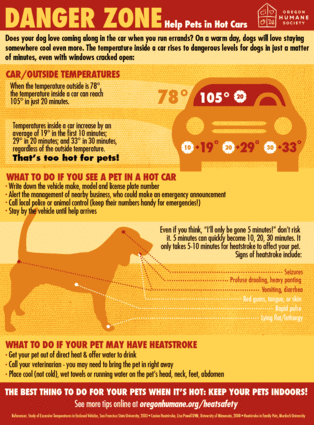Extreme heat is very dangerous for pets
Last updated 7/27/2022 at Noon
Sisters Country will see temperatures soar back into the high 90s this week, with a prediction of 100 degrees on Thursday. With high temperatures comes increased risks for heat-related illness, for people and animals.
The Oregon Humane Society (OHS) works to get the word out on how dangerous high heat can be for pets — and how quickly the effects can become dire.
The best place for your pet to be during the heat of the day is inside with you, keeping cool, OHS recommends keeping pets indoors and out of the heat, if possible.
“If you see an animal in distress because of the heat, please take immediate steps to help, in addition to calling local police,” OHS states. “Provide the pet with a bowl of cool water; create a shady area where the animal can relax; set up a water sprinkler for the animal; knock on the doors of neighbors to see if anyone has access to the animal’s house. If possible, bring the pet indoors.”
The Oregon Humane Society encourages you to leave your pet home and inside when you dash to the store or another errand. The inside of a car heats up very quickly. On an 85-degree day, a car’s interior temperature can climb to 120 degrees in 20 minutes, even with the windows slightly open.
What to do if you see a pet alone in a hot car:
•?Write down the car’s make, model, and license plate number.
•?If there are businesses nearby, notify their managers or security personnel and ask them to make an announcement to find the car’s owner.
•?If the owner can’t be found, call the nonemergency number of the local police and/or animal control and wait by the car for them to arrive.
Can you break a car window to save a life?
The public, as well as police, can now break a car’s window to rescue a pet or child in imminent danger without fear of being sued for damages. The new law, which took effect in June of 2017, protects people from criminal and civil liability if they break a car window to save a child or animal who is left alone and appears to be in imminent danger.
Breaking a window is a last resort: before a Good Samaritan chooses to break a car window, law enforcement must be contacted (call police or 911 in an emergency). Rescuers must stay with the animal until first responders arrive or the owner of the car returns.
The OHS urges pet owners to be alert to the signs of heat-related illness.
Symptoms of heatstroke include restlessness, excessive thirst, heavy panting, lethargy, lack of appetite, dark tongue or gums, vomiting, lack of coordination or even collapse, and an internal temperature over 104 degrees Fahrenheit. Contact your veterinarian immediately if you notice these symptoms. Quick action could save your pet’s life.
Help your pet cool down: First, get your pet out of direct heat. Check for signs of shock and take your pet’s temperature if possible. Offer water to drink. Then: use a fan to blow cool air on the pet; place water-soaked towels (or running water) on the pet’s head, neck, feet, chest, and abdomen; rub isopropyl alcohol (70 percent) on a dog’s foot pads for cooling (do not allow dog to ingest). Do not use ice-cold water or ice—use cool water to avoid shock.
“During a heat crisis, the goal is always to decrease the animal’s body temperature to 103 degrees Fahrenheit in the first 10 to 15 minutes,” the American Red Cross states. “Once 103 degrees Fahrenheit is reached, you must stop the cooling process because the body temperature will continue to decrease and can plummet dangerously low if you continue to cool the dog for too long.
“Even if you successfully cool your pet down to 103 degrees Fahrenheit in the first 10 to 15 minutes, you must take the dog to a veterinarian as soon as possible because consequences of heat stroke will not show up for hours or even days. Potential problems include abnormal heart rhythms, kidney failure, neurological problems, and respiratory arrest.”
Pavement, asphalt, metal, and even sand that have been heated by the sun can burn dogs’ paw pads. If the surface is too hot for your bare hand or foot, it’s too hot for your dog’s feet. Pads can be soft and more sensitive after swimming, so take heed if your pup refuses to walk on the pavement after a swim.
Some ways to avoid pad burns:
•?Walk your dog early or late in the day, out of the heat.
•?Walk frequently when it’s cool to build up callus on the pads.
•?Walk on the grass when hot surfaces are unavoidable.
•?Moisturize your dog’s pads daily with paw balms or creams.
•?Lay down a wet towel for your dog to stand on when grassy areas are not available.
Signs of burned pads include limping or refusing to walk, licking or chewing at the feet, pads darker in color, missing part of pad, blisters or redness on the feet.
First aid for burned pads: Keep the foot area cool and clean. Immediately flush with cool water and a gentle antibacterial such as betadine. Get the dog to a grassy area or, if possible, carry him/her. Keep the dog from licking the wounds. For minor burns, spread the area with antibacterial ointment and cover with a loose bandage.
For serious burns, take the dog to your vet for further treatment. This is important to prevent infection and further damage.
Generally speaking, keep your dogs off of hot surfaces whenever possible.












Reader Comments(0)